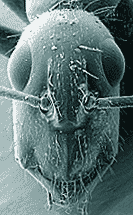Filed under: Great websites / blogs | Tags: Ant, Entomology, Museum collection, Myrmecology
Just want to share the address of a website I found this morning and I simply loved.

The Royal Belgium Institute of Natural Sciences has a website dedicated to the ants of Paraguayan Chaco: RBINS Ant eMuseum. The website is developed by a team led by the Belgium entomologist Maurice Leponce and the French entomologist Thibaut Delsinne. The website offers access to the records of the species collected in Paraguay with details for the different specimens and tons of microscopic pictures. The design is very neat and the navigation on the website really pleasant.
But to me the real treasure of this website is an excellent glossary which is richly illustrated with amazing pictures. Probably the best anatomical glossary I have seen so far! Thank you for this useful tool.
The website also offers an interactive identification key and description of the different project. I am looking forward to see the future developments…
Finally, if you want to learn more about the ants of Paraguay don’t miss the work made by the entomologist and photographer Alex Wild (aka Myrmecos) on Antweb and its catalog of the ants of Paraguay published in 2007 in Zootaxa.
One last thing. Take some time to look at the animation that I borrow from the RBINS Ant eMuseum homepage, a surprise is awaiting you with the Camponotus.
Species and genus names are often repulsive for many students, and the picture below illustrates probably how a young student would dream his pathway in biology.

However, names often have a function and/ or a story. This is what I would like to talk about today.
Species names can have a specific function which is to carry some information relative to the species itself. For example, it can provide information on the color, such as in Lasius niger (niger in latin means black), the morphology (Pheidole megacephala = giant head), the size (Plagiolepis pygmaea), the behavior or ecology (Camponotus sylvaticus, sylva means forest in latin), on the provenance (Brachymyrmex patagonicus, from Patagonia in Argentina),…
But it can also be more personal, …
Often the author chooses a name in homage to someone else. Most of the time this is one of their colleague or less often a member of their family. For example the new world genus Forelius was described in 1888 by the Italian myrmecologist Carlos Emery in honor of the Swiss Auguste Forel, and a few years later, in 1912 Forel described the new Oriental genus Emeryopone (can you guess in honor of who?). One more example with the beautiful African genus Santschiella described by Auguste Forel in 1916 probably in honor of the Italian myrmecologist Felix Sanstchi. Some other obvious genera names dedicated to myrmecologists are Bondroitia, Mayriella, Rogeria, or Wasmannia.
However, sometimes the species name is more surprising. For example today, I went through Pheidole harrisonfordi described by E.O. Wilson in 2003. It first made me laugh, but then I learned, thanks to my colleague Mike Weiser, that Harrison Ford was really involved into conservation, especially with Conservation International. I found these two links that describes a little more the reason why Han Solo deserved an ant species dedicated: CI link 1; and CI link 2
Another story which was famous a few years ago was the description by Brian Fisher in 2005 of a new ant from Madagascar: Proceratium google. More info available on the official Google blog.
An other ant name that I like is the east European ant, Bothriomyrmex communista, described by Santschi from a specimen collected in Crimea (Russia) in 1919. Two years after the Bolshevik revolution in October 1917. Who said that History and Biology could not get along with each other?
Finally a name that has intrigued me at some point was Stenamma debile. In French (my native language), “debile” means stupid/ idiot. I thought that maybe A. Forster, the myrmecologist that described this species, was upset the day he described the species and decided to pass his frustration on the subject of his research. The fact is that in Latin, “debile” means weak, and so it refers probably to the morphology of the ant than its intellectual capacity! And when I looked at the picture of S. debile, it can be perceived as a sort of fragile ant.
Let me know if you have more anecdotes or some name that you prefer for some reasons.